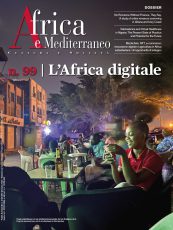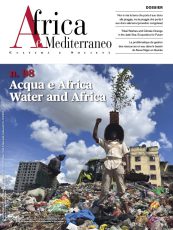African laboratory
Africa e Mediterraneo n. 97 (2/22)
African laboratory
Africa e Mediterraneo n. 97 (2/22)
Issue 97 of Africa e Mediterraneo opens up a space for scholars and experts to share their research on topics relating to Africa and migration, without thematic limitations. At a time of strong changes both on the continent and in Africa’s relationship with the world and the Mediterranean countries in particular, the issue identifies three foci of interest: the Italian colonial past and the present history of the Horn of Africa, the frontiers of migration, and what we have called the “African laboratory,” which brings together topical topics such as Covid-19 and relations with China.
Relations between Ethiopia and Eritrea and the prospect of a lasting peace after the conflict that recently ended are the subject of the contributions by Tekeste Negash and Andebrhan Welde Giorgis. Negash updates his reflections appeared in Africa e Mediterraneo’s 92-93 issue discussing the main events relating to the relations between Ethiopia, Eritrea, and the Tigrayan People’s Liberation Front. Although the area has recently experienced a war that caused huge suffering to the population and loss of lives, the search for a peaceful solution continues. Welde Giorgis offers an in-depth overview of the history of the bond between Eritrea and Ethiopia looking specifically at the border issue, which for decades has exacerbated the conflict and fueled the antagonism of the TPLF. The recognition by both sides of the borders established in 2001 by the Eritrea-Ethiopia Boundary Commission would bring stability and preserve the identity of the two states.
Vincenzo Straface also writes about Ethiopia in an essay on the architectural history of Addis Ababa, which was the capital of Italian East Africa and the site of colonial experiments of segregationist urbanism. In the plans of the colonial architects, the new city, which was never completed, would serve the needs of the Italian minority and reflect its ideology of racial superiority. Federica Colomo explores the role of women in Italian colonialism in Africa, a topic that is yet to be fully explored by Italian historiography. Colomo describes the “burden” of the Italian woman in the colonies as one that renders her both dominating and dominated, as participant in a patriarchal culture that places her in a gender hierarchy that grants her no other freedom than that of exercise power over the colonized.
The routes of migration in the Mediterranean, and the experiences of children born into migrant families, are the focus of three articles. The first, by Alberto Catania, concerns the Spanish territories in North Africa, in particular the exclaves of Ceuta and Melilla, which mark Europe’s southernmost border. These places are sadly known for being the backdrop, in recent years, of violent episodes of repression and confinement of people who tried to reach Europe via the Moroccan route. Fabiana D’Ascenzo writes of Lampedusa and Lesvos, other sites of transit and arrival of migrants, where she has conducted fieldwork. D’Ascenzo looks into the changes that are affecting these islands in the context of a broader transformation of the perception of the Mediterranean, today understood more and more as a “barrier” in defense of which Europe mobilizes growing means and resources.
Second-generation experiences of migration are the focus of Sabrina Alessandrini’s contribution, based on interviews with Italian teenagers and young adults of African origin. Here the themes of arrival and destination found in the articles acquire a different meaning in the testimonies of those who grew up knowing they live between two worlds.
The remaining articles concern important current topics from which the theme of African agency strongly emerges, understood as a desire to act for oneself, according to principles rooted in indigenous cultures.
Barbara De Poli presents a case study of the controversial management of the pandemic by the late Tanzanian president P. J. Magufuli, who did not implement emergency measures of containment, rather relying on natural remedies and prayer, effectively depriving the Tanzanian population of health protection. On the basis of the economic and health data available for the period 2020-2022, Magufuli’s policy appears as a measure that, limited to the first few months, paradoxically proved to be saving, preventing the social and financial collapse of the country. Covid also appears in Giulia Allegra Liti’s contribution as one of the contingencies in which the Ghanaian queer artist crazinisT artisT stage their performances. This non-binary artist practices creative forms of resistance and radical self-assertion, denouncing the discrimination faced by LGBTQI+ people in Ghana. Priscilla Manfren also writes about resistance through art, focusing on the production of four African artists who reappropriate the expressive modalities of European art, provoking reflections on the legacy of colonialism and on other themes, like gender issues and globalization.
Referring to the Lebanese magazine WatWat, Enrica Battista and Maria Laura Romani explore the state of young adult comics in Algeria, Egypt, Morocco and Tunisia, where some cartoonists have tried to fill an “editorial void”, finding in comics for that demographic a field of continuous experimentation. WatWat, disseminated online and on social networks and based on an inclusive production also made by the teenagers themselves, is a successful publication that has caught the attention of many readers. Maria Argenti, Anna Bruna Menghini and Francesca Sarno write about inclusive architecture in the global South, looking specifically at Africa, where they find several examples of a successful mediation between nature, sustainability and local needs. Antonella Ceccagno and Mariasole Pepa analyze the recent academic debate on the Chinese presence in Africa, highlighting the polarization of opinions and the importance of focusing attention on the response of different African countries to the development vision promoted by the Asian giant, and the role of the African agency in redefining the growth model.
Finally, this issue of Africa e Mediterraneo marks the appointment of Enrica Picarelli as editorial director of the journal, alongside Sandra Federici who remains in the role of managing director.








